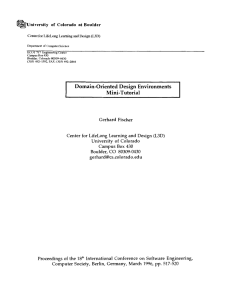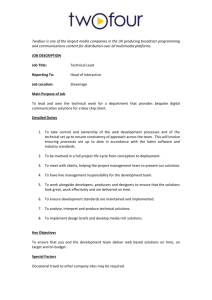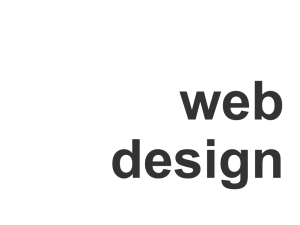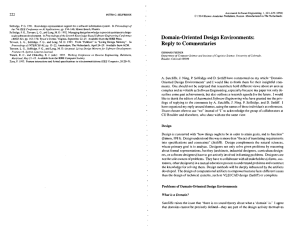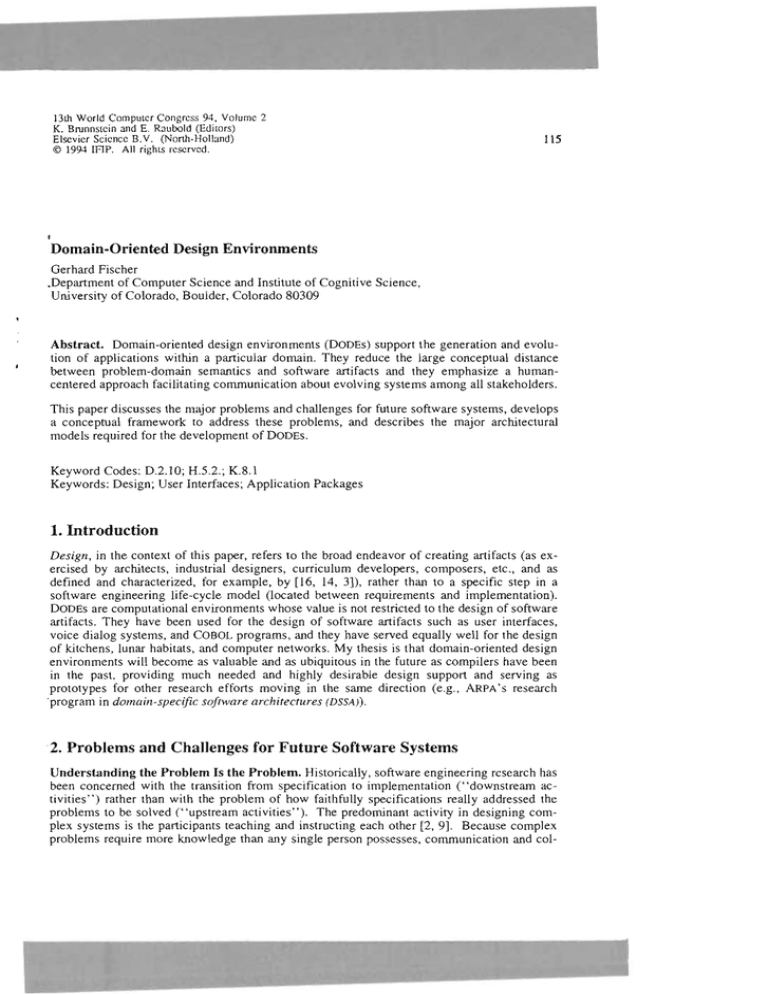
13th World Computer Congress 94, Volume 2
K. Brunnstein and E. Raubold (Editors)
Elsevier Science B.Y. (North· Holland)
© 1994 IFlP. All rights reserved.
115
Domain-Oriented Design Environments
Gerhard Fischer
.Department of Computer Science and Institute of Cognitive Science,
University of Colorado, Boulder, Colorado S0309
Abstract. Domain-oriented design environments (DODEs) support the generation and evolution of applications within a particular domain. They reduce the large conceptual distance
between problem-domain semantics and software artifacts and they emphasize a humancentered approach facilitating communication about evolving systems among all stakeholders.
This paper discusses the major problems and challenges for future software systems, develops
a conceptual framework to address these problems, and describes the major architectural
models required for the development of DODEs .
Keyword Codes: D.2.1O; H.5.2.; K.S.l
Keywords: Design; User Interfaces; Application Packages
1. Introduction
Design , in the context of this paper, refers to the broad endeavor of creating artifacts (as exercised by architects, industrial designers, curriculum developers, composers, etc., and as
defined and characterized, for example, by [16, 14, 3]), rather than to a specific step in a
software engineering life-cycle model (located between requirements and implementation).
DODEs are computational environments whose value is not restricted to the design of software
artifacts. They have been used for the design of software artifacts such as user interfaces,
voice dialog systems, and COBOL programs, and they have served equally well for the design
of kitchens, lunar habitats, and computer networks. My thesis is that domain-oriented design
environments will become as valuable and as ubiquitous in the future as compilers have been
in the past, providing much needed and highly desirable design support and serving as
prototypes for other research efforts moving in the same direction (e.g., ARPA'S research
'program in domain-specific software architectures (DSSA).
2. Problems and Challenges for Future Software Systems
Understanding the Problem Is the Problem. Historically, software engineering research has
been concerned with the transition from specification to implementation ("downstream activities") rather than with the problem of how faithfully specifications really addressed the
problems to be solved ("upstream activities"). The predominant activity in designing complex systems is the participants teaChing and instructing each other [2, 9]. Because complex
problems require more knowledge than any single person possesses, communication and col-
116
laboration among all the involved stakeholders are necessary. Domain designers understand
the practice and environment developers know the technology. To overcome this "symmetry
of ignorance" [13] (i.e., none of these carriers of knowledge can guarantee that their
knowledge is superior or more complete compared to other people's knowledge), as much
knowledge from as many stakeholders as possible should be activated with the goal of achieving mutual education and shared understanding.
•
Integrating Problem Framing and Problem Solving. Design methodologists (e.g., [13, 14])
demonstrate with their work the strong interrelationship between problem framing and
problem solving. They argue convincingly that (1) one cannot gather information meaning-'
fully unless one has understood the problem, but one cannot understand the problem without
information about it and (2) professional practice has at least as much to do with defining a
problem as with solving a problem. New requirements emerge during development because
they cannot be identified until portions of the system have been designed or implemented.
The conceptual structures underlying complex software systems are too complicated to be
specified accurately in advance, and too complex to be built faultlessly. Specification and
implementation have to co-evolve, requiring the owners of the problems to be present in the
development.
Limitations of Formal Specifications and CASE Tools. Many research efforts do not take
into account the growing evidence that system requirements are not so much analytically
specified as they are collaboratively evolved through an iterative process of consultation between end-users and software developers [1]. For example, CASE tools devise elaborate
methods of insuring that software meets its specification but hardly ever question whether
there might be something wrong with the specifications themselves. They provide support
only after the problem has been solved. A consequence of the thin spread of application
knowledge [2] is that specification errors often occur when designers do not have sufficient
application domain knowledge to interpret the customer's intentions from the requirement
statements - a communication breakdown based on a lack of shared understanding [12].
The main objective of formal specifications is that they are "formal," which means that they
are manipulable by mathematics and logic and interpretable by computers. As such, these
representations are often couched in the language of the computational system. However,
such representations are typically foreign and unintelligible to end-users and get in the way of
trying to create a shared understanding between designers and their clients. Ehn [3] notes that
representations for mutual understanding (such as prototypes, mock-Ups, sketches, scenarios,
or use situations that can be experienced) are essential "objects-to-think-with" in the design
of complex software systems.
The Need for Change. Software systems model parts of our world. Our world evolves in
numerous dimensions as new artifacts appear, new knowledge is discovered, and new ways of.
doing business are developed. Successful software systems need to evolve. Maintaining and
enhancing systems need to become "first class design activities." Systems cannot be done
"right" for their entire lifetime when they are originally designed, which requires their users
to be able to extend and modify them according to their needs.
Understanding People and Their Work. Nothing can be worse than designers who think
everyone else is just like them [9]. In the early days of computing, almost all systems were
developed and used by computer professionals. Introspection by software designers served as
a reasonable source of knowledge at that time, but it has lost its power today for the development of systems in application domains. Research in software engineering in the past has
117
operated as an overly prescriptive discipline, often postulating a "new human" [16] with interests (e.g., detailed knowledge of low-level computer operation), knowledge (e.g., about
work procedures of an application domain), and motivations (e.g., to provide extensive
amounts of design rationale, or to deal with formal methods), which had little correspondence
with reality.
3. A Theoretical and Conceptual Framework for DODEs
Communication and Coordination. Because designing complex systems is an activity involving many stakeholders, communication and coordination are of crucial importance [9, 7].
By emphasizing design as a collaborative activity, DODEs support three types of collaboration
(see Figure 2): (I) collaboration between domain-oriented designers and clients, (2) collaboration between domain designers and design environment developers, and (3) long-term indirect
collaboration among designers (creating a virtual collaboration between past, present, and future designers). Design environments provide representations that serve as representations for
mutual understanding [3] and therefore help increase the shared context [12] necessary for
collaboration.
Domain-Orientation. In a conventional, domain-independent software environment, designers who produce new software artifacts typically have to start with general programming
constructs and methodologies [15]. This forces them to focus on the raw materials necessary
to implement a solution rather than to try to understand the problem. Design environments
need to support human problem-domain communication by providing computational environments that model the basic abstractions of a domain (as pursued in efforts in domain modeling). DODEs give designers the feeling that they interact with a domain rather than with lowlevel computer abstractions. Domain-orientation allows humans to take both the content and
context of a problem into account, whereas the strength of formal representations is their independence of specific domains to make domain-independent reasoning methods
applicable [11].
Modem application needs are not satisfied by traditional programming languages, which
evolved in response to system progranuning needs. More emphasis should be put on the
creation of computational environments that fit the needs of professionals of other disciplines
outside the computer science community. The chief risks of using ideas from programming
language design and formal specification techniques are in succumbing to the temptations of
excess generality and in assuming that users and domain experts think like software designers.
The semantics of DODES are tuned to specific domains of discourse. This involves support
for different kinds of primitive entities, for specification of properties other than computational functionality, and for computational models that match the users' own models.
Evolution. There is growing agreement and supporting empirical data that the most critical
software problem is the cost of maintenance and evolution [1]. Studies of software costs indicate that about two-thirds of the costs of a large system occur after the system is delivered.
Much of this cost is due to the fact that a considerable amount of essential information (such
as design rationale [5]) is lost during development and must be reconstructed by the designers
who maintain and evolve the system.
The evolution of a software system is driven by breakdowns [8] experienced by the users of a
system. In order to support evolutionary processes, domain designers need to be able, willing,
and motivated to change systems, thereby providing a potential solution to the maintenance
.
,
,
'
,
~
"
•
"
>
'"
>
<
."
.
,
.
.
. , .
118
and enhancement problems in software design. Users of a system are knowledgeable in the
application domain and know best which enhancements are needed. An end-user modification component supports users in adding enhancements to the system without the help of the
system developers. End-user modifiable systems will take away from system developers
some of the burden of anticipating all potential uses at the original design time.
4. Domain-Oriented Design Environments
In the last several years, DODEs have been developed for the following domains: user inter:
face design, kitchen design, decision support for water management, computer network
design (see Figure I), voice dialog design, COBOL programming, graphics programming, and
lunar habitat design (details are provided in [4]).
CJD
IWil:J.
G'Zm
E~
g
~
Ef:
~
0 0 ~C>
0 I 6'@
-<l-<l
{l
··· r
.. , ii~:
Figure 1: Network -
'1
a Design Environment for Computer Network Design
A Domain-Independent Architecture for DODEs. Based on the numerous design efforts
creating DODEs as well as on an analysis of the shortcomings of previous efforts, we have
developed a domain-independent, multi-faceted architecture to serve as a starting point and
organizing framework in the creation of specific DODEs. The major components of this ar~
chitecture are:
• A construction kit is the principal medium for modeling a design. It provides a palette
of domain concepts and supports construction using direct manipulation and electronic
forms. It supports design by composition .
• An argumentative hypermedia system contains issues, answers , and arguments about
the design domain and the design rationale for a specific application built within the
domain .
•
,
:
.;- -
,
- : -.
-;--.
-
-
•
.
•
.
••
.
•
' . .
"
r
' .
..
, , _ . . .
-
-
I'
-'
I, -
-
-
"- - ,
.
.
.
... ' ,
......
t"
:.
'
~
•
- ~
I
,
I
,
. '
- . -
•
~
119
• A catalog is a collection of prestored designs that illustrate the space of possible
designs in the domain and support reuse and case-based reasoning. The primary design
activity supported by the catalog is design by modification.
• A specification component supports the interaction between clients and designers to
describe characteristics of the design they have in mind. The specifications are expected to be modified and augmented during the design process, rather than fully articulated at the beginning. They are used to retrieve design objects from the catalog and to
filter information in the hypermedia information space.
• A simulation component allows designers to carry out "what-if' games to simulate
various usage scenarios involving the artifact being designed.
Integration. The multi-faceted architecture derives its essential value from the integration of
its components. Used individually, the components are unable to achieve their full potential.
Used in combination, each component augments the values of the others, forming a synergistic whole. At each stage in the design process, the partial design embedded in the design
environment serves as a stimulus to users and suggests what they should attend to next. Links
among the components of the architecture are supported by various mechanisms:
• The CONSTRUCTION-ANALYZER is a critiquing system [6] that provides access to
relevant information in the argumentative issue base. The firing of a critic signals a
breakdown to users and provides them with an entry into the exact place in the argumentative hypermedia system where the corresponding argumentation is located.
• The explanation given in argumentation is often highly abstract and very conceptual.
Concrete design examples that match the explanation help users to understand the concept. The ARGUMENTATION-ILLUSTRATOR [5] helps users to understand the information given in the argumentative hypermedia by finding a catalog example that illustrates the concept.
• The CATALOO-ExpLORER helps users to search the catalog space according to the task
at hand [8]. It retrieves design examples similar to the current construction situation and
orders a set of examples by their appropriateness to the current specification.
Seeding, Evolutionary Growth, and Reseeding: A Process Model for DODEs. To account
for the evolutionary nature of complex environments that model real-world systems, we have
developed a process model for DODE that relies on three major phases: seeding, evolutionary
growth, and reseeding (see Figure 2).
A seed for a domain-oriented design environment is created through a participatory design
process between software designers and domain experts by incorporating domain-specific
knowledge into the domain-independent multi-faceted architecture underlying the design environment. Seeding entails embedding as much knowledge as possible into all components of
the architecture. But any amount of design knowledge embedded in design environments will
never be complete because (I) real-world situations are complex, unique, uncertain, con. flicted, and instable and (2) knowledge is tacit (i.e., competent practitioners know more than
they can say, implying that additional knowledge is triggered and activated only by experiencing breakdowns in the context of specific use situations.
Evolutionary growth takes place as domain experts use the seeded environment to undertake
specific projects for clients. During these design efforts, new requirements may surface (e.g.,
the design of a kitchen for people who are blind or in wheelchairs), new components may
120
Env;ronmtHJt
~v~opMs
Domain
iHsigtMt"S
:,:~
Environment
Dom4in
Chvtt/opt!Irs
De.ignttrs
~-~
Evolutionary Growth
ill -- -i--lIIl '
_~Of_o.'_ign_EnV_iron_m.n_t~~ ~
Reseeding' _
New Domain Knowledge
----------------------------------------------------~~ Time
Figure 2: Seeds, Evolutionary Growth, and Reseeding: A Process Model for DaDEs
During seeding, environment developers and domain designers collaborate to create a design environment seed that captures an application domain. During evolutionary growth, domain designers
(e.g., professional kitchen designers) create specific artifacts. Breakdowns (e.g., the lack of support
for specific designs, the ongoing appearance of new components and new knowledge) experienced
by the domain designers leads to the addition of new domain knowledge to the seed. In the reseeding phase, environment developers again collaborate with domain designers to organize, fonnalize,
and generalize new knowledge.
come into existence (e.g., microwaves) and additional design knowledge not contained in the
seed may be articulated (e.g., that appliances should be against the wall unless we have an
island kitchen). During the evolutionary growth phase, the software designers are not present.
Therefore it is highly desirable that the new design knowledge can be added by the domain
expert requiring computational mechanisms that support end-user modifiability and end-user
programming [10].
Reseeding, a deliberate effort at revision and coordination of information and functionality,
brings the environment developers back in to collaborate with domain designers to organize,
formalize, and generalize knowledge added during the evolutionary growth phases. Organizational concerns play a crucial role in this phase. For example, decisions have to be>
made as to which of the extensions created in the context of specific design projects should be
incorporated in future versions of the generic design environment.
5. Conclusions
The appeal of the DaDE approach lies in its compatibility with an emerging methodology for
design [3, 14, 16], with views of the future as articulated by practicing software engineering
experts [I], with findings of empirical studies [2], and with the integration of many recent
j
I
'.
'~'.:~:~; '~:'~: 2~ /~,~~ .~.... :'.
~
• -. •
/' ,:' :~.~;,:
-<
._''-''J._', " '"
,~',;. ':,1,
I
'i'
.'
121
efforts to tackle speci fic issues in software design (e.g., recording design rationale, supporting
case-based approaches, and creating artifact memories [4]). We are further encouraged by the
excitement and widespread interest of DODEs and the numerous prototypes being constructed,
used, and evaluated in the last few years .
•DODEs (see Figure 3) will lead to further specialization of computer users into environment
"developers who create (in cooperation with domain experts) the seeds for design environments, and of domain experts who solve problems by exploiting the resources of the design
environments. Support for end-user modifiability allows domain experts to extend the
'functionality of the design environment over time.
~
:
,
I.
'
,
,. ,-' .
"-' I "
i
t
" " "
""
"
"
Assembly
Languages
Programming
Languages
,
"
"
'
" ,
'
"
,
Design
Environments
Problem
Domains
Figure 3: Layered Architectures in DO DEs
In the I 950s, progra mmers had to map problems directly to assembly languages and the assembly
programs retained no semantics of the problems to be solved. In the 1960s, general purpose highlevel programming languages reduced the transformation distance, which allowed programs to
retain some problem semantics and the programming profession was specialized into compiler
writers and programmers who developed programs in high-level programming languages.
Design environments reduce the gap between problems and their descriptions as computational artifacts. They make it more likely that software systems correspond to the needs of
their users. They facilitate the development and evolution of a particular application within a
domain. It is our belief and our hope that they constitute examples of environments within
which the majority of future software systems will be developed.
J\cknowledgments
This work de scri bed is founded on the numerou s contributions of the members of the HumanComputer Communication group at the University of Colorado who contributed to the conceptual
framework and the sy stems discussed in this article.
The research was supported in part by ( 1) the Nationa l Science Foundation under grant
MDR-9253245, (2) NYNEX Science and Technology Center (White Plains, N.Y.), (3) Software
Research Associates , Inc. (Tokyo, Japan ) and (4) the Colorado Advanced Software Institute.
122
References
[1] Computer Science and Technology Board, "Scaling Up: A Research Agenda for Software Engineering", Communications of the ACM, Vol. 33, No.3, March 1990, pp. 281-293.
[2] B. Curtis, H. Krasner, N. Iscoe, "A Field Study of the Software Design Process for Large.
Systems", Communications of the ACM, Vol. 31, No. 11, November 1988, pp. 1268-1287.
..
[3] P. Ehn, Work-Oriented Design of Computer Artifacts, Almquist & Wiksell International, Stockholm, Sweden, 1988.
[4] G. Fischer, "Domain-Oriented Design Environments", Automated Software Engineering, Vol.
1,1994, (in press)
[5] G. Fischer, A.C. Lemke, R. McCall, A. Morch, "Making Argumentation Serve Design",
Human Computer Interaction, Vol. 6, No. 3-4, 1991, pp. 393-419.
[6] G. Fischer, A.C. Lemke, T. Mastaglio, A. Morch, "The Role of Critiquing in Cooperative
Problem Solving", ACM Transactions on Information Systems, Vol. 9, No.2, 1991, pp.
123-151.
[7] G. Fischer, 1. Grudin, A.c. Lemke, R. McCall, 1. Ostwald, B.N. Reeves, F. Shipman, "Supporting Indirect, Collaborative Design with Integrated Knowledge-Based Design Environments",
Human Computer Interaction, Special Issue on Computer Supported Cooperative Work, Vol.
7, No.3, 1992, pp. 281-314.
[8] G. Fischer, K. Nakakoji, "Beyond the Macho Approach of Artificial Intelligence: Empower
Human Designers - Do Not Replace Them", Knowledge-Based Systems Journal, Vol. 5, No.
1,1992, pp. 15-30.
[9] J. Greenbaum, M. Kyng, editors, Design at Work: Cooperative Design of Computer Systems,
Lawrence Erlbaum Associates, Hillsdale, NJ, 1991.
[10] B.A. Nardi, A Small Matter of Programming, The MIT Press, Cambridge, MA, 1993.
[11] D.A. Norman, Things That Make Us Smart, Addison-Wesley Publishing Company, Reading,
MA,1993.
[12] LB. Resnick, "Shared Cognition: Thinking as Social Practice," in Perspectives on Socially
Shared Cognition, LB. Resnick, J.M. Levine, S.D. Teasley, eds., Washington, D.C.: American
Psychological Association, 1991, pp. 1-20, ch. 1.
[13] H.WJ. Rittel, "Second-Generation Design Methods," in Developments
Methodology, N. Cross, ed., New York: John Wiley & Sons, 1984, pp. 317-327.
in
Design
[14J D.A. Schoen, The Reflective Practitioner: How Professionals Think in Action, Basic Books,
New York, 1983.
[15] M. Shaw, "Maybe Your Next Programming Language Shouldn't Be a Programming Lan-:
guage," in Scaling Up: A Research Agenda for Software Engineering, Computer Science and
Technology Board, eds., Washington, D.C.: National Academy Press, 1989, pp. 75-82.
[16] H.A. Simon, The Sciences of the Artificial, The MIT Press, Cambridge, MA, 1981.

